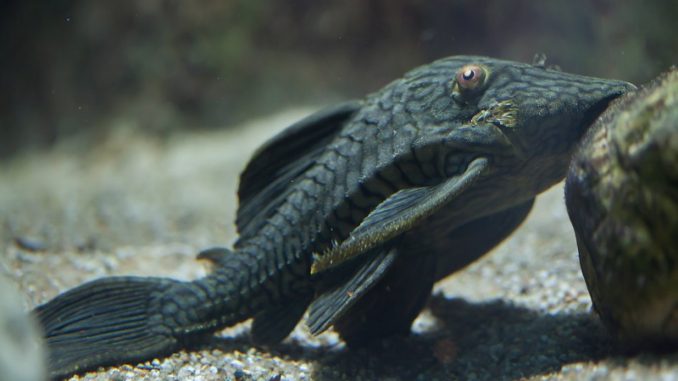
If you have the space for a larger aquarium, you might consider adding some pomp and circumstance with royal plecos. With their light and dark grey stripes, these large freshwater fish stand out in any aquarium.
When you peer into a 120-gallon tank and see a royal pleco staring back at you with its bright red eyes, it is truly striking.
Caring for these oversized plecos is not a complicated venture, but they do have some idiosyncrasies, so it’s important to know all the ways that you can keep these bottom feeders happy and healthy. They have a long life expectancy–about 10 years–so you want to make sure to provide them with optimal care so that they thrive and reach their full potential.
Starting with their origin story and native habitat as a basis for study, in this primer I’ll cover water parameters, tank requirements, best cohabitants, diet, disease, and much more. You’ll be prepared to welcome these armored 17 inches of catfish into your community tank.
TABLE OF CONTENTS
Royal Pleco Facts & Overview
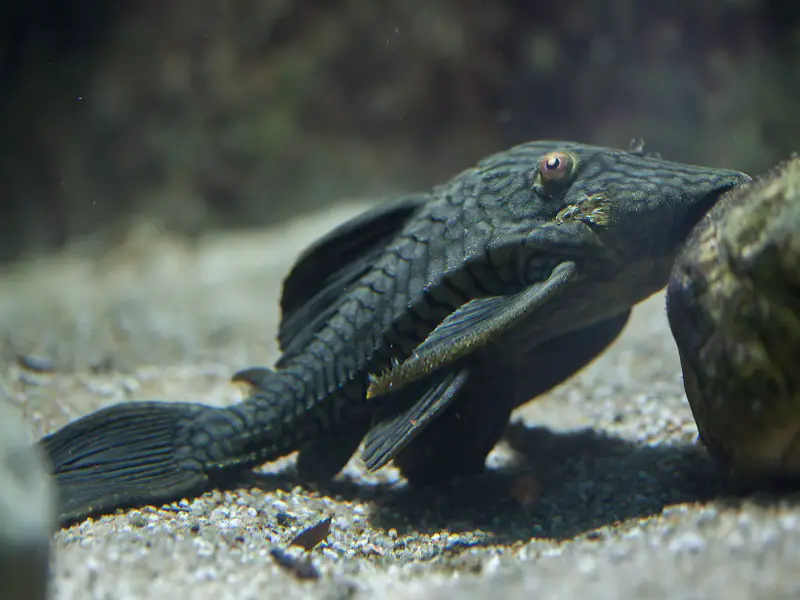
| Category | Rating |
| Care Level: | Easy |
| Temperament: | Somewhat territorial |
| Color Form: | Light and dark grey stripes |
| Lifespan: | 10 years |
| Size: | 17 inches |
| Diet: | Herbivore |
| Family: | Loricariidae |
| Minimum Tank Size: | 120 gallons |
| Tank Set-Up: | Freshwater with plants and rocks |
| Compatibility: | Aggressive with other plecos |
Royal Plecos, scientific name Panaque nigrolineatus , are known to originate in South America in the basins of the Amazon and Orinoco Rivers. One fascinating fact about Royal Plecos is their unique ability to digest wood, so you’ll want to make sure you have some driftwood in your tank.
Found in countries such as Brazil, Columbia, Peru, and Venezuela, Royal Plecos have been imported for the aquarium trade for many years. With slight variations in their physical appearance, there are a number of different types of Royal Plecos; although they are physically distinct, their behavior is quite similar.
When the aquarium trade offers Royal Plecos for sale, the catfish are identified by the letter L (for when they are offered on sale, the royal plecos are given unique numbers starting with L, for the Loricariidae family) and a number indicating their subspecies. I’ll be focusing on the most commonly seen Panaque
nigrolineatus, but I do want to introduce the species in its glorious entirety.
Royal Pleco Subspecies
The L27 series includes the L27, L27A, L27B, and L27C.
The L27 is native to the Rio Tocantins and Rio Xingu areas of Brazil.
The L27A is similar to L190, and also comes from Brazil, in the Rio Xingu area. It is also called the Platinum Royal Pleco.
The L27B is also called the Gold Thunder.
The L27C, also known as the Gold Line or Thunder Line Pleco, has one of the more interesting color forms and is regarded as one of the more attractive of the Royal Plecos. The L27C comes from Brazil’s Rio Tapajos.
The L190 Royal Pleco is the star of the Royal Pleco line and is by far the most known of the Royals. L190s hail from Columbia and Venezuela in the acidic Rio Orinoco, where they enjoy moderate to fast currents.
The L191, also known as the White-Tailed Royal Pleco and the Full-Eyed Pleco, is from Columbia and Venezuela, specifically the Rio Meta and Caqueta areas.
The L330 Royal Pleco, also from Columbia, is known as the Spotted Royal Pleco or Watermelon Royal Pleco.
There are three Royal Plecos that come from Peru. The L418 is also called the Peruvian Green Royal Pleco or Shampupa Pleco. The L90 is an attractive Royal Pleco also called the Papa Royal Pleco. And the L203, the Peruvian Black Royal Pleco, is the largest of the Royal Plecos, reaching 24 inches (61cm). They are also called Volkswagen Plecos due to their size.
Again, all of these subspecies are common in behavior and have identical care needs; they vary slightly in physical appearances, such as size or coloring.
Typical Behavior
As long as they are not in sight of other Royal Plecos or catfish, these fish are extremely peaceful and will not use their large size to bully other aquarium dwellers. They are truly gentle giants.
Because they have a longer life expectancy of 10 years, a Royal Pleco owner must be committed to attentive care for the long haul. In order to reach their full potential, Royal Plecos need optimal conditions; this encompasses everything from a clean tank to enough space to swim freely.
Given the proper environment, they will happily enjoy their lives scavenging and exploring the bottom level of their aquarium home, without a thought to their neighbors in the middle and top water columns.
Royal Plecos are also nocturnal and will spend the better part of the day hiding under their precious driftwood. At night, they are more active, and this is when you can observe the Royal Plecos slowly swimming around the bottom of the tank, in search of food.
One important behavior note is Royal Plecos’ aggressive behavior towards each other and towards other catfish. They will ignore every other creature in the tank except for each other. That’s why I don’t recommend keeping Royal Plecos in the same tank.
Appearance
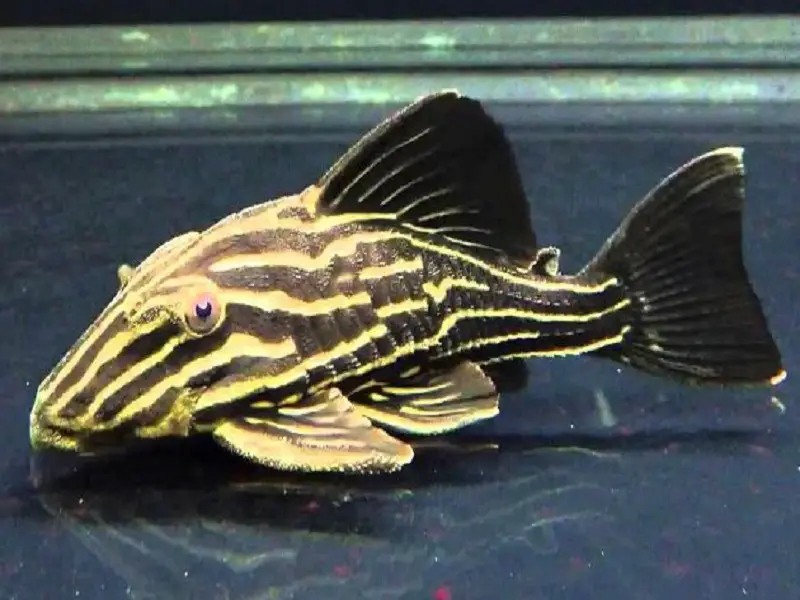
The most noticeable feature about the appearance of Royal Plecos is their size. The more common L190s average about 17 inches (43 cm). They grow slowly but steadily, which is one reason you need a large tank that offers them the opportunity to grow to their intended size.
Fun Fact: Some of the Peruvian Royal Plecos are even bigger, reaching a size of as much as 24 inches (nearly 61 cm!)
As for coloring, Royal Plecos have light grey bodies with striking dark grey stripes. Sometimes the dark grey is black, and sometimes their bodies look more brownish than grey. The stripes are not uniform, and therefore every Royal Pleco has a unique pattern. Every once in a while, you will even see one that has spots instead of stripes.
Their features resemble other plecos, including the common pleco that tips down, their large heads, and generous fins (watch out for tank mates that like to nip!) However, Royal Plecos are bulkier than other plecos, and so they appear more intimidating as they look taller and stronger than some other plecos. This extra bulk is mostly noticeable in the Royal Pleco’s head.
Other features that set Royal Plecos apart from the crowd are their large mouths and spoon-shaped
wood chopping teeth.
The Royal Pleco’s signature red eyes are eerie and captivating, really standing out against their grey bodies.
If you are familiar with other plecos and catfish, you won’t be surprised that Royal Plecos have no scales, but instead sport touch skin plates that act as protective armor. These plates cover the Royal Pleco’s whole body, but the underbelly is softer, so choose a substrate that is not too soft.
Habitat and Tank Conditions
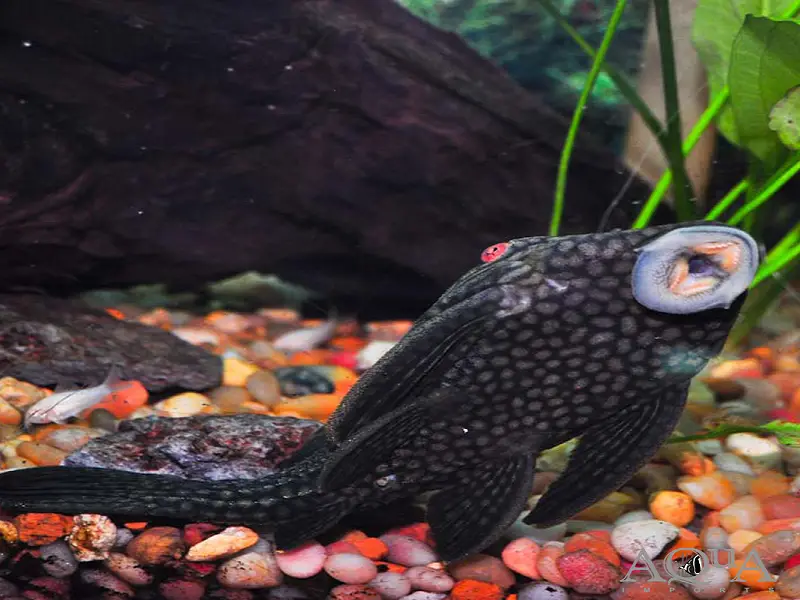
Royal Plecos are bottom dwellers, so substrate and bottom planting are the areas you want to pay attention to when planning your aquascape. If you have a community tank, you’ll have to provide for the needs of your mid and top dwellers, too, but when curating the bottom of the tank, you should only be trying to please your royalty.
You could use gravel as a substrate for Royal Plecos, but soft sand would be my go-to substrate. You don’t want them to scrape their underbellies on a rough substrate. The other issue with gravel is that you want to make sure that the pieces are not so small that the Royal Plecos end up swallowing them.
Driftwood is a non-negotiable element of the Royal Pleco’s aquascape. Get different kinds if you can. Royal Plecos have special bacteria in their gut that allows them to digest wood–it’s pretty cool! Also, the algae and organisms on the wood provide other important nutrients that Royal Plecos need.
You can add plants if you want to add to the ambiance of the tank, but the Royal Plecos do not need them. They will feed on plant detritus if they find it on the bottom of the tank, and that’s ok. However, they also have a tendency to chew plant leaves, and they can’t digest plastic and silk, so make sure you use live plants rather than artificial ones.
One benefit of having plants is that they will help keep the lighting dim, as is the preference of Royal Plecos. If you don’t have plants, keep the lighting levels low.
Finally, Royal Plecos are big fish, and big fish create big waste. You will need a strong filter with a heavy flow to properly cycle the tank and clean out all the toxins. You don’t want ammonia or nitrate levels to get too high.
Water Conditions
With Royal Plecos, it is imperative to test the water conditions on a regular basis and perform weekly 25% water changes; they are extremely sensitive to fluctuating water conditions because they have no scales.
One of the parameters that are important to check for is pH, as the tannins that are released from the wood in the tank can lower the pH to dangerous levels.
It is also important to vacuum the bottom of the substrate to remove extra waste and extra wood pieces.
Pro tip: If you are ignoring my advice and trying to breed Royal Plecos, don’t vacuum when they are spawning, or you may suck up the Royal Pleco eggs that are hidden in the substrate debris.
You want to try to recreate the water conditions in their natural habitat in the river basins of South America. In the wild, they enjoy water that is warm and dark, with plenty of food to scavenge. Their natural water is neutral to slightly hard, so test to make sure the water in your home aquarium is not too soft for their liking.
The optimal parameters to ensure a close match to their natural habitat are:
- pH levels: 6.6 to 7.5
- Water hardness: 5-10 dKH
- Water temperature: 72-78°F to °F (22.2-25.6°C)
What Size Aquarium Do They Need?
Go big or go home is my motto with Royal Plecos. They need a tank size of at least 125 gallons. Anything smaller than this will crowd the Royal Plecos, both stressing them out and compromising their health. If they don’t have enough room, their growth will be stunted, which could also shorten their lifespan.
Volume is important, but so is size. Royal Plecos are really big and unable to navigate corners and turn. You want to make sure that your tank is at least 24 inches so that they can comfortably maneuver their way around the tank.
Tank Mates
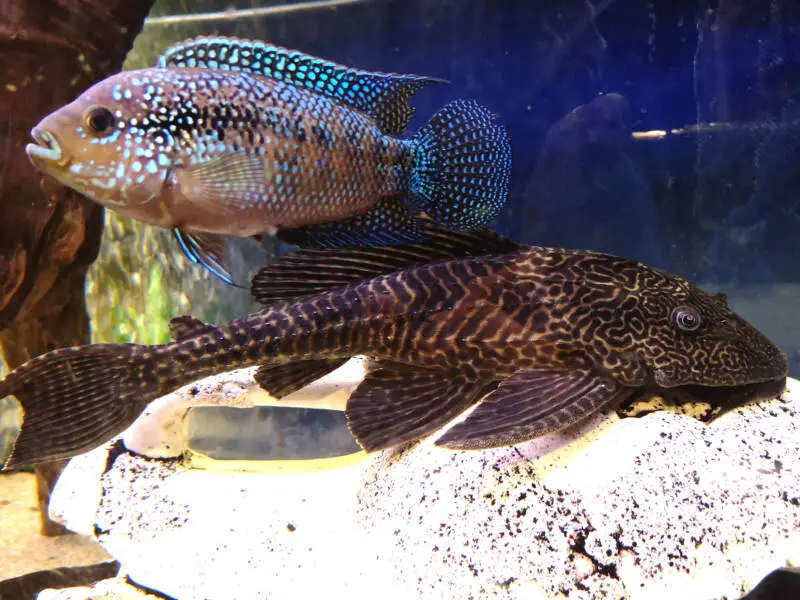
Since Royal Plecos are bottom dwellers and nocturnal, it is best to find tank mates that occupy the mid to upper levels of the tank, as well as those that are more active during the day; that way, the different species will not be competing with each other for tank space or attention.
It’s best to choose peaceful and mellow tank mates for Royal Plecos; they are only aggressive with their own kind, and if they are paired with more aggressive fish, it can stress them out, endangering their health.
In addition to avoiding aggressive fish, it is also a poor idea to house them with faster, more energetic swimmers. Royal Plecos are not the most adept swimmers, and therefore are unable to defend themselves if a faster fish nips at them or threatens them.
Suitable Tankmates
- Angelfish
- Black Skirt Tetra
- Bloodfin Tetra
- Congo Tetra
- Flag Cichlids
- Headstanders
- Jaguar Cichlid
- Rummy Nose Tetra
- Silver Arowana
- Silver Dollar Fish
Keeping Royal Plecos Together
Royal Plecos are very aggressive towards their own kind, and towards other catfish, so it is better to house a single Royal Pleco. This is one of the reasons I do not recommend breeding Royal Plecos in a home aquarium. Unless you are able to secure a pair of Royal Plecos that is already bonded, I would not try pairing them up.
Diet
Royal Plecos are omnivores, and while they eat a mostly plant-based diet, they do enjoy some meatier food. I’ve mentioned that they have a penchant for wood consumption. They actually have teeth that have evolved into wood carving machines. They almost look like spoons and the tips are larger than the base.
These special teeth, in conjunction with their powerful jaws, enable Royal Plecos to demolish wood. It’s important to remember, however, that they are not just consuming wood. They are also getting nutrition from the algae, detritus, and microorganisms that are on the wood.
In addition to the wood and its companions, Royal Plecos will feed on plants and detritus from the floor of the tank–they are bottom dwellers. What you can provide for the Royal Plecos is the bulk of their diet: flakes, pellets, and wafers, both algae-based and meatier, as well.
They also enjoy blanched vegetables, such as cucumbers, peas, and zucchini.
Variety in food choices is important for the well-being of your Royal Plecos.
Care
Maintaining consistent conditions is key to ensuring Royal Plecos will thrive. These large catfish don’t handle environmental changes well, so you want to maintain their water parameters. They are also sticklers for a clean tank, so make sure to maintain cleanliness by using a strong filter, performing regular water changes, and testing the water levels.
Although Royal Pleco care is not complicated, it is necessary. Keep their stress levels down by maintaining a clean tank, and you will also reduce their risk of developing diseases that commonly afflict freshwater fish. Royal Plecos are susceptible to the parasitic ich disease, as well as bacterial and fungal infections.
Many over-the-counter medications for ich and other diseases contain copper, which is toxic for Royal Plecos. The lack of scales makes them extremely sensitive to medication containing copper. Quarantine is necessary for Royal Plecos with ich. After separating them, you will have to raise the water temperature over a period of days to try to eliminate the ich.
For other diseases, Royal Plecos should be ok if you treat them with Pleco-friendly medications.
Remember, too, that if you are treating other aquarium species with copper medications, you will have to quarantine them. Even if the Royal Pleco is not being directly treated, they can still be harmed by copper medication in the tank.
Breeding
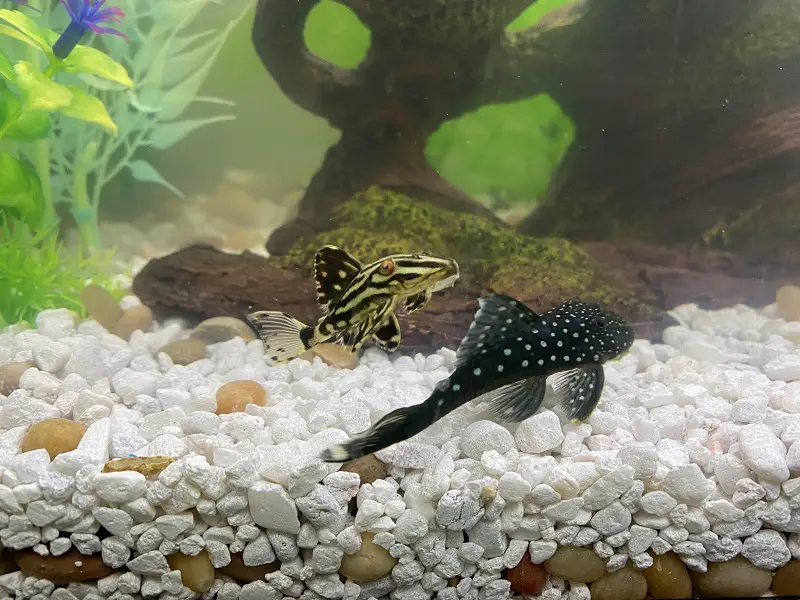
Royal Plecos are not easy to breed in captivity. Quite honestly, I don’t recommend trying this task at home. Successful breeding rarely happens in a home aquarium. You can find information on the Internet about how to go about attempting to breed them. However, because I think it is unfair to the fish and potential fry to try to breed in captivity, I will instead list the reasons it is so challenging to try.
- In their natural habitat, Royal Plecos mate during the rainy season, when the water conditions change. Recreating these water conditions in your home tank is nearly impossible.
- Royal Plecos form bonded pairs to mate, which would imply that you would have to have a tank large enough to accommodate multiples since you can’t guarantee that two will bond.
- Royal Plecos, as I have discussed, are very aggressive against their own species, so confining multiples to a tank, even a large one, is asking for trouble.
Although professional breeders have successfully bred Royal Plecos in captivity, it is best to leave that task to the experts.
Are Royal Plecos Suitable for your Aquarium?
If space is not an issue for you, Royal Plecos really do make for a special aquarium. They are attractive, colorful, unique, and are not difficult to care for.
They also have a long lifespan, so they will be in your aquarium family for about 10 years. They have a couple of special needs; for example, because they don’t have scales, they are sensitive to copper, so you have to take care when treating your Royal Plecos and other fish for diseases.
But as long as you get to know the Royal Plecos and their specific needs, they are great pets who will bring you years of enjoyment and satisfaction.
Are Royal Plecos the king and queen of your aquarium? Let us know why in the comments below…

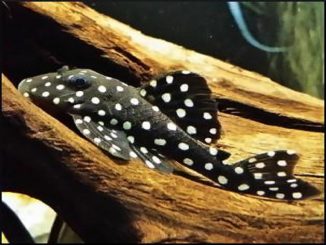
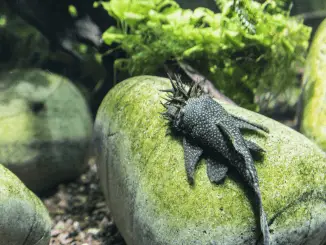
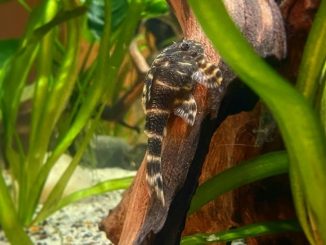
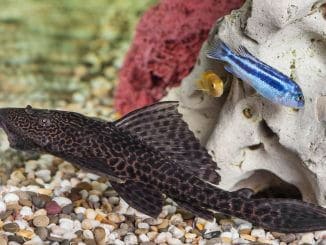
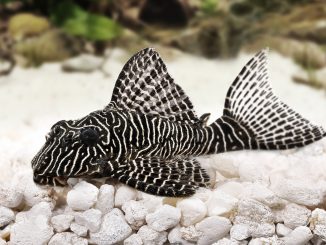
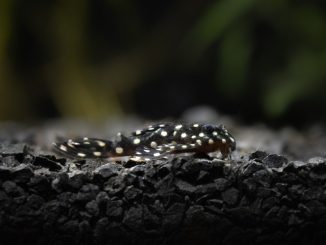
Be the first to comment